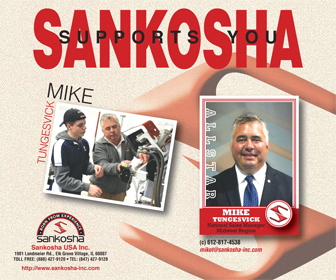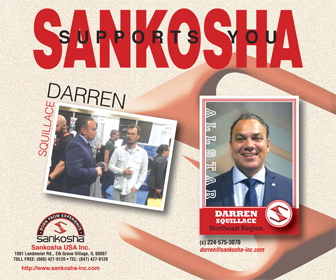Supply shortages ripple through the industry

The pandemic has had an impact on every industry on the planet. It’s not surprising that, as we move forward, there are glitches in the supply chain that will have long-term ramifications for cleaners and launderers in terms of new equipment and repairs.
We asked industry leaders across the board to comment on this situation. Some declined to answer, letting us know it is a sensitive subject that deserves attention. Those who were willing to go on the record have keen insight into what is happening and what they expect the immediate future will hold.
What’s in short supply?

Director of Supplies
“In the past year and a half we have had extraordinary raw material shortages and price spikes. In addition, container shipments have been affected by overseas delays, along with a national shortage of drivers and skyrocketing freight costs,” George Manikis and Lou Mignardi of Dalex Canada said.
Their comments are echoed by all of our participating experts, in one form or another. Some are missing specific items, others just feel the overall drag in the supply chain.
“We’ve seen short supply pretty much across the board,” said Jensen’s Pedro Sosa. “Steel, electronics, motors, raw materials, fabrications, packaging supplies. Combined with extended lead times and price increases, it has been a challenging year.”
“For us, it’s mostly electronic parts,” said Wesley Nelson of Sankosha.
Daniel Gelac of Kannegiesser reported, “There have been some shortages in steel and electronics, but also electronic components such as transformers.”

“Our most difficult component to keep supply of has been small motors for our single-phase dryers,” said Al Adcock of B&C Technologies. “The manufacturer of these motors has had quite a bit of difficulty with raw materials and therefore their production has been fairly unpredictable this year so far.”
“The industry is feeling pressure related to the supply of laundry equipment and the related parts to support the products,” said Mike Pilolli of Coinamatic Commercial Laundry. “There is also a shortage of staff ready to perform on production lines, and ongoing shipping delays causing an extreme backlog. Manufacturers continually extend their lead times on orders, and delays continue due to a variety of factors, including new delays caused by forest fires.”
Tom Stites, of Unipress Corp., pointed out that there are over 10,000 parts used to manufacture their current line and maintain and support older production models. “We have a long-term relationship with the majority of our vendors,” he said. “They try to give us advance notice of upcoming shortages, which helps in managing supplies. We’ve learned not to cry wolf with our vendors, and run a hot list of our required items for them to concentrate on.”

Being proactive pays off
Shortages rarely come out of nowhere. There are early warning signs, and successful business people learn to read those signs and act accordingly.

“Fortunately, we anticipated the high demand and quickly prepared the business by securing equipment in the nine warehouses we have across Canada,” said Coinamatic’s Pilolli. “We continue to place blanket orders to ensure the stock is replenished, based on a minimum stock on hand. We meet with our major suppliers on a regular basis to ensure we understand their challenges so we can collectively decide on alternatives to ensure we meet demand requests as best as we can.”
“With our forecasting and production models in place, as soon as we started to witness a few supply chain areas being affected, a total review was completed to start sourcing broader areas of supply and then aggressively adjusted orders to our plants,” said Miele’s Timpano. “This helped lessen the impact, yet not completely avoid the challenges most all manufacturers are facing.”
Everyone has had to make accommodation to the new normal of the world economy.
“Kannegiesser has coped by modulating production and using the inventory we had on hand. Equipment has been coming out of the factory nearly on a regular schedule, and the impact has been minimal,” said Gelac.

“We have gone to utilizing multiple vendors for the same components,” said Nelson at Sankosha. “Also we have, without compromising quality, used compatible or interchangeable components to meet demand, for both our production line and replacement parts for existing customers. Logistics have been challenging. What we used to ship primarily in ocean containers, we’ve shifted some of those deliveries to air shipments, to try and ensure a steady supply for our customers.”
Stites said Unipress was quick on the mark when shortages began. “When Covid first started to cripple our industry, we decided to build equipment for stock,” he said. “With the uptick in the industry, we are pulling from our inventory and trying to replace it as necessary.”
What’s on the shelf?
One of the blessings of ‘just in time’ fulfillment is that there is no large warehousing of products waiting to be ordered.. One of the downsides, however, is that when snags show up in the chain, everything suffers. We asked our experts if they were drawing on back-stock to smooth the bumps in the pipeline.
“We have nine fully stocked warehouses currently,” said Pilolli, citing Coinamatic’s foresight as the crisis began. “We also have refurbished inventory available for sale, and different buying programs that will accommodate and assist all types of clients as it relates to their current financial position.”

Miele also has stock on hand. “Across the board,” said Timpano, “while we supply to the commercial laundry segment, we also serve the lab, medical and dental industries, where consumables and service parts have also been very important to meet the needs of our customers.”
Many companies build equipment specific to the customers’ needs, so back-stock is not available. Some refurbish, but on a limited basis.
“Directly from Sankosha USA Inc. we rarely have refurbished equipment,” said Nelson. “In most cases we refer customers to their local authorized Sankosha distributor for these requests. We do support our distributors in refurbishing projects where possible. However, we have taken the firm stance of providing direct support to our customers, whether they purchase a new or used Sankosha product. Our sales team in the field is ready and available to provide in-person support at no charge.”
“Dalex does refurbished equipment at times, but we carry new equipment in affordable price points for those who will need replacements,” said Manikis and Mignardi. “The majority of trade-ins that we accept are laundry equipment and finishing pieces.”

“Our equipment is produced on-demand,” said Kannegiesser’s Gelac, “so during Covid we have been able to fulfill orders with parts inventory we had on hand. At the same time, we do have some equipment in stock all the time, such as feeders and folders.”
Adcock said of B&C, “Like most companies, we tried to do our best to hedge against current conditions while looking towards the future. I think the real surprise is how quickly the spigot turned back on, leading to material shortages throughout the supply chain.”

What’s going to happen to prices?
“Capitalism is driven by the supply-and-demand equation,” said Adcock, “and due to the increased demand with limited supplies, no one should be surprised how quickly prices went up. The good news is that, recently, there seems to be some stabilization. Transportation continues to be an issue, and those costs continue to be high/unpredictable in the short term. Hopefully, this sector returns to some kind of normal shortly.”
Everyone is concerned about the mounting additional costs involved in transportation and logistics.
“Equipment prices will not increase much more than other years,” Gelac said. “Where we see a major change is on freight costs.”

“The cost on everything is going up and will affect pricing,” said Stites. “The area that we have seen the most immediate impact is freight rates. They are up dramatically. For years we were able to ship a truckload of equipment for just a little over a dollar a mile; now it is over $2.00+ a mile.”
Pilolli concurred. “Pricing has increased like most items have during this pandemic – not only on raw materials, but labour, gas, shipping costs. At this time, we do not foresee any reductions. This may be a long-haul thing. Laundry and the proper cleaning of laundry is an essential service, especially during a pandemic, and the demand for equipment has not diminished. Neither has the labour required to maintain it.”
“A few equipment prices have been impacted,” said Jensen’s Sosa, “but not all. We are doing all we can at Jensen to minimize the impact on our customers. Shortages will take several months to catch up with demand.”
Stites said it is up to individual companies how they integrate the volatility of the supply chain into their overall sales activities. “The question will be more so how companies strategically implement this type of impact to production, and how best to lessen impact to our customers over the next 18 months to two years.”
Sankosha has already made the decision to stick with its planned pricing schedule. “We have not increased prices since January 1, 2020 (pre-Covid) and we are staunchly avoiding a knee-jerk reaction price increase. Our next regular minimal price increase is anticipated on January 1, 2022, but is not a direct result of Covid; rather it is adjusting for the periodic normal rise in the cost of doing business,” said Nelson.
What should you be doing now?
The mood across the industry is more optimistic than a year ago.

“We see business increases in several areas of the country – some stronger than others,” said Sosa at Jensen. “Our customers are reacting to these increases in a very positive way with new equipment purchases, new plants being built, and increased spare parts sales to properly maintain their equipment.”
Kannegiesser’s Gelac agreed. “Business has already picked up, and it is time to invest and automate your process at the same time.”

Dalex Canada Inc.,
Nat’l. Equipment Sales Mgr.
Dalex foresees changes in business, requiring changes in equipment. “Cleaners should be looking at automating their facilities as much as possible to counterbalance this development, as well as expand the services that they offer,” said Manikis and Mignardi. “We anticipate a shift in services required and a shortage of labour in the industry.”
Stites sees the same trend at Unipress. “We have seen a dramatic increase in owners/managers performing their own maintenance and service on equipment. At any one time we can have five members of our parts and service team engaged in assisting customers. Our recommendation, when it comes time to purchase equipment, is to concentrate on equipment that will reduce labour and that is easy to operate and train. The vast majority of time when a new piece of equipment is installed, we provide on-site training. As the labour market tightens, this is becoming a very valuable service to our customer base.”
“I’m advising all of our distributors to get your orders in now!” said B&C’s Adcock. “It costs nothing to cancel if it turns out you don’t need the piece of equipment, but waiting for things to settle down is likely to cost you sales in the short term at least.”
The length of the pandemic and the worldwide shutdowns that followed infection rates across the globe have taken a toll on equipment, as well. These bring special circumstances to the table.
“In many cases, equipment sat idle for periods of time resulting in different maintenance and recommissioning issues than usual,” said Nelson at Sankosha. “This has required us to provide a larger role than usual in customer support, both in person and remotely.”
Communication is definitely key to getting through the tight supply chain challenges.
“Regarding equipment purchases, we are giving customers realistic delivery dates,” Nelson said. “Overall, our pipeline is strong. Now that we have resumed ‘normal’ shipments, lead times are only slightly longer than usual for most models. We are also advising customers to provide us with orders and expected installation dates at their earliest convenience, so that we can do our best to meet their expectations.”
“It’s really about communication and needs,” said Miele’s Timpano. “We’ll work closely with our customers to serve them as they’ve always been accustomed to, in trying to stay as ‘normal’ as possible, but if required we can openly discuss support options, whether that’s for equipment purchases or servicing necessities.”
“It is important that we are on the same page as our clients and understand the impact their business has had from Covid,” concluded Pilolli at Coinamatic. “We appreciate that Covid has changed how we view our businesses, and that we must accommodate to ensure our partners stay in business for many years to come. Our team is learning and changing every day, and we encourage continued conversations.”








